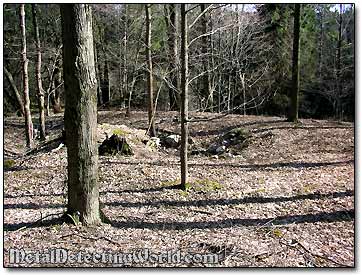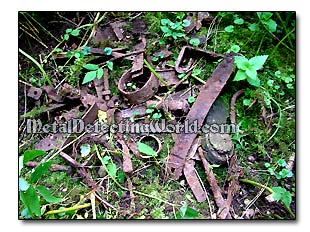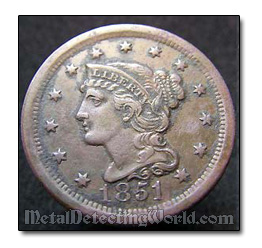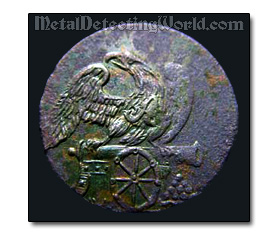How To Search a Former Homestead Site Located in Remote Area, page 7
Metal Detecting Strategy for "Searched-Out" Hunt Sites
Just like in the case of searching the "virgin" site, when you arrive at the "searched-out" metal detecting site, focus on the most logical places to conduct your search. But now, what matters the most is not only how you analyze your surroundings and deduce what actions made people lose possessions and where, but also how you figure out what actions or inactions of previous metaldetectorists could lead to their leaving a few "fruitful" spots undetected.

Former Homestead Site with a Cellar Hole - Now a Depression

Iron Junk Discarded by Preceding Detectorists
Of course, you could not possibly have seen who did what at the site before you got there. Many times, all you can see is the proof of someone's metal detecting activity - a pile of discarded metallic objects placed on the foundation corner or dumped next to it.
So, just like in "seeing" the homestead site by the eyes of its former inhabitants who lived here 150+ years ago, try to think which spots other detectorists would start searching first and what spots they would leave for the last.
The latter would be your choice for searching first! Pay special attention to the hard-to-detect spots which most of enthusiasts would not want to bother with. Those spots better be your second priority!
With a few exceptions, most metal detectorists would go metal detecting at the easiest and most accessible spots. To search the "hunted out" site successfully, do the opposite! However, "each stick has two ends": sometimes the most obvious spot is left behind undetected by all!
Satisfactory results in metal detecting the "searched out" homestead site can be achieved by applying one of the two following strategies:

1851 Large Cent
Braided Hair/Mature Head
1) If you are not limited with time to metal detect the entire site, slow your detecting speed and search all spots, described in a previous chapter, with a small search coil, and later search them with a large coil.
The only difference in searching now would be that you will have to dig every "big" and "questionable" signal produced by an iron target, and preferably in All Metal mode, because a desirable target might be lying under it and be completely or partially masked.
You certainly will be recovering more junk targets unless you are using the most advanced XP Deus metal detector which can effectively separate good targets from iron junk in the surface layer.
If you use the Deus metal detector for searching around cellar holes, you may want to utilize my Search Program for Detecting at Former Homestead Sites (it will be published soon). If you use E-Trac or CTX 3030, you might want to check out My Program for Minelab E-Trac and CTX 3030 especially designed for the "hunted out" sites.

1812 War 2nd Regiment Artillery Button
2) If you do not have enough time to meticulously search the entire location, metal detect with a large search coil fast while moving in a grid pattern of search and look for a "hot" spot surprisingly left unsearched by everybody who previously hunted this site.
The "hot" spot would be a small area anywhere at the site, where a few coins or buttons are still to be found. Believe it or not, but there is always a "hot" spot left by everybody at every "hunted out" site!
I always tried to figure out an explanation to this "phenomenon" - why one particular spot at any site gets ignored by all searchers? Is something paranormal involved?
Well, such a spot had been "hot" from the beginning (when the first metal detectorist arrived) and continued yielding coins year after year for the following basic reasons:
- 1) Winter frosts caused some coins to change their positions in the ground from vertical to "detectable".
- 2) "Moisturized Soil Signal-Enhancing Effect" usually takes place after raining, and amplifies electromagnetic fields emitted by deep and small non-ferrous targets including coins; thus, making them detectable for some time until the soil gets dry again.
- 3) Preceding detectorists would have used too much Conventional Discrimination and, therefore, missed some deep coins and valuable buttons which could be partially masked by the iron nails. Many times I was extremely happy to benefit from someone's love for Discrimination!
- 4) Preceding detectorists had wrong settings of Discrimination (either Conventional or Tonal): accepting/rejecting ranges for certain targets on Conductivity scale were set up without considering the "Mixed VDI Value Effect" (described in my article "Factors That Affect VDI Readings of Non-Ferrous Targets"). As a result, most coins at the "hot" spot were accidentally rejected by a Discriminate circuit (Conventional Discrimination) or ignored by the detectorists themselves (Tonal Discrimination).
- 5) This "hot" coin spot could also be a "red-hot pocket" - a spot containing an extremely high level of mineral content which resulted from former human activity that took place here in the past. And most metal detectors that were used at this spot most likely could not handle a huge variety of responses to the ground. Nothing to say about many coins being accidentally rejected again due to the "High Mineralization Effect" that would lower VDI readings of coins and other non-ferrous targets (more details on this effect are given in the above-mentioned article), and then the same as what is described in the above paragraph happened.
- 6) Preceding detectorists were in a big hurry. I would strongly advise against making haste while metal detecting around cellar holes because this is the best prescription for missing lots of coins and frustration.
If you are limited with time for metal detecting, come back to your hunt site later and resume your meticulous search from a point where you previously stopped. Do not try to "pound" the entire hunt site in one day! I never can stop myself from laughing inside when someone tells me, "we hit a few cellars today but did not find much..." There is an old saying: "Fool's haste is no speed." Please keep that in mind when you are at the cellar hole site.
But of course, there are also "original" hot spots, such as a PORCH SPILL spot and a CLOTHESLINE STRIP (definitions will be given in my Glossary of Metal Detecting Terms soon), at the former homestead site, which you should NEVER forget about.